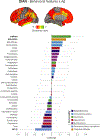Amyloid and Tau Pathology Associations With Personality Traits, Neuropsychiatric Symptoms, and Cognitive Lifestyle in the Preclinical Phases of Sporadic and Autosomal Dominant Alzheimer's Disease
- PMID: 32228870
- PMCID: PMC7415608
- DOI: 10.1016/j.biopsych.2020.01.023
Amyloid and Tau Pathology Associations With Personality Traits, Neuropsychiatric Symptoms, and Cognitive Lifestyle in the Preclinical Phases of Sporadic and Autosomal Dominant Alzheimer's Disease
Abstract
Background: Major prevention trials for Alzheimer's disease (AD) are now focusing on multidomain lifestyle interventions. However, the exact combination of behavioral factors related to AD pathology remains unclear. In 2 cohorts of cognitively unimpaired individuals at risk of AD, we examined which combinations of personality traits, neuropsychiatric symptoms, and cognitive lifestyle (years of education or lifetime cognitive activity) related to the pathological hallmarks of AD, amyloid-β, and tau deposits.
Methods: A total of 115 older adults with a parental or multiple-sibling family history of sporadic AD (PREVENT-AD [PRe-symptomatic EValuation of Experimental or Novel Treatments for AD] cohort) underwent amyloid and tau positron emission tomography and answered several questionnaires related to behavioral attributes. Separately, we studied 117 mutation carriers from the DIAN (Dominant Inherited Alzheimer Network) study group cohort with amyloid positron emission tomography and behavioral data. Using partial least squares analysis, we identified latent variables relating amyloid or tau pathology with combinations of personality traits, neuropsychiatric symptoms, and cognitive lifestyle.
Results: In PREVENT-AD, lower neuroticism, neuropsychiatric burden, and higher education were associated with less amyloid deposition (p = .014). Lower neuroticism and neuropsychiatric features, along with higher measures of openness and extraversion, were related to less tau deposition (p = .006). In DIAN, lower neuropsychiatric burden and higher education were also associated with less amyloid (p = .005). The combination of these factors accounted for up to 14% of AD pathology.
Conclusions: In the preclinical phase of both sporadic and autosomal dominant AD, multiple behavioral features were associated with AD pathology. These results may suggest potential pathways by which multidomain interventions might help delay AD onset or progression.
Keywords: Alzheimer’s; PET; Prevention; Reserve; Resistance; Risk factors.
Copyright © 2020 Society of Biological Psychiatry. Published by Elsevier Inc. All rights reserved.
Conflict of interest statement
The authors report no biomedical financial interests or potential conflicts of interest.
Figures




References
-
- Livingston G, Sommerlad A, Orgeta V, Costafreda SG, Huntley J, Ames D, et al. (2017): Dementia prevention, intervention, and care. Lancet 390:2673–2734. - PubMed
-
- Kivipelto M, Mangialasche F, Ngandu T (2017): Can lifestyle changes prevent cognitive impairment? Lancet Neurol 16:338–339. - PubMed
-
- Norton S, Matthews FE, Barnes DE, Yaffe K, Brayne C (2014): Potential for primary prevention of Alzheimer’s disease: An analysis of population-based data. Lancet Neural 13:788–794. - PubMed
Publication types
MeSH terms
Substances
Grants and funding
LinkOut - more resources
Full Text Sources
Other Literature Sources
Medical

